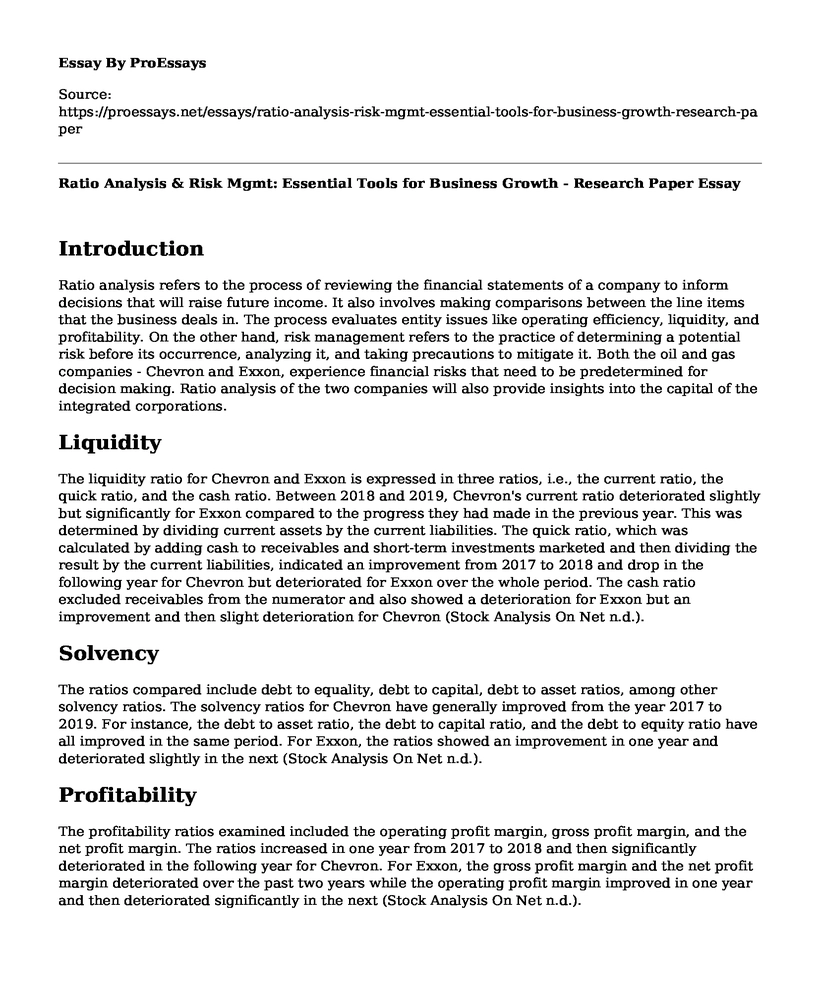Introduction
Ratio analysis refers to the process of reviewing the financial statements of a company to inform decisions that will raise future income. It also involves making comparisons between the line items that the business deals in. The process evaluates entity issues like operating efficiency, liquidity, and profitability. On the other hand, risk management refers to the practice of determining a potential risk before its occurrence, analyzing it, and taking precautions to mitigate it. Both the oil and gas companies - Chevron and Exxon, experience financial risks that need to be predetermined for decision making. Ratio analysis of the two companies will also provide insights into the capital of the integrated corporations.
Liquidity
The liquidity ratio for Chevron and Exxon is expressed in three ratios, i.e., the current ratio, the quick ratio, and the cash ratio. Between 2018 and 2019, Chevron's current ratio deteriorated slightly but significantly for Exxon compared to the progress they had made in the previous year. This was determined by dividing current assets by the current liabilities. The quick ratio, which was calculated by adding cash to receivables and short-term investments marketed and then dividing the result by the current liabilities, indicated an improvement from 2017 to 2018 and drop in the following year for Chevron but deteriorated for Exxon over the whole period. The cash ratio excluded receivables from the numerator and also showed a deterioration for Exxon but an improvement and then slight deterioration for Chevron (Stock Analysis On Net n.d.).
Solvency
The ratios compared include debt to equality, debt to capital, debt to asset ratios, among other solvency ratios. The solvency ratios for Chevron have generally improved from the year 2017 to 2019. For instance, the debt to asset ratio, the debt to capital ratio, and the debt to equity ratio have all improved in the same period. For Exxon, the ratios showed an improvement in one year and deteriorated slightly in the next (Stock Analysis On Net n.d.).
Profitability
The profitability ratios examined included the operating profit margin, gross profit margin, and the net profit margin. The ratios increased in one year from 2017 to 2018 and then significantly deteriorated in the following year for Chevron. For Exxon, the gross profit margin and the net profit margin deteriorated over the past two years while the operating profit margin improved in one year and then deteriorated significantly in the next (Stock Analysis On Net n.d.).
Operating Efficiency
In terms of operational efficiency, Chevron's performance indicators were better than those of Exxon. They included inputs like operational and capital expenditure as well as outputs like revenue, service quality, and customer satisfaction. This explains the reduction in profits as well as solvency and liquidity ratios for Exxon (Stock Analysis On Net n.d.).
Return on Investment
Chevron has had better returns on investment as opposed to Exxon. For Chevron, the ROI has constantly been increasing over the past ten years without a significant drop. Exxon's ROI fluctuated too far below in 2019 from the level it was in 2018. This can be attributed to reduced investment leading to reduced income (Ambalangodage 20).
Summary and Explanation
In conclusion, the drop in incomes or returns for Exxon can be determined to be coming from poor customer services or reduced quality of products. It can also relate to pricing strategies used by the corporation. To avoid the risk of the business going under, the company needs to check its operational costs that are affecting prices and also seek to improve quality and customer services (Kokobe and Gemechu 126). Chevron has invested in better operational performance and a strong base of high-quality assets compared to the rival Exxon. For this reason, the company has a competitive advantage over its rivals. The operational efficiency improvement and the good returns for the company are a result of the increased investment.
Works Cited
"Stock Analysis On Net." Stock Analysis On Net, 2020, https://www.stock-analysis-on.net/.
Ambalangodage, Nimindu Bimsara. "Process Improvement/Supply Chain Management and Electrical Engineering Stocks Vs. Market Risk." (2019). https://digitalcommons.wpi.edu/cgi/viewcontent.cgi?article=8075&context=mqp-all
Kokobe, S. A., and D. Gemechu. "Risk management techniques and financial performance of insurance companies." International Journal of Accounting Research 4.1 (2016): 126-127. http://www.academia.edu/download/57437194/001.pdf
Cite this page
Ratio Analysis & Risk Mgmt: Essential Tools for Business Growth - Research Paper. (2023, Apr 08). Retrieved from https://proessays.net/essays/ratio-analysis-risk-mgmt-essential-tools-for-business-growth-research-paper
If you are the original author of this essay and no longer wish to have it published on the ProEssays website, please click below to request its removal:
- Accounting Information for Financial Management - Essay Example
- The Background and History of the Companies Contending for the Government Contract
- Research Paper on Impact of ISO Regulations on Stakeholders in Saudi Arabia
- Nature's Grocery and Walmart Grocery Case Study
- Operational Strategy: Case Study, Apple Inc.
- Essay on Maximizing Profits in Challenging Economic Times: Understanding Internal Factors
- Essay Example on Public Leadership: A Collective Activity for the Community







